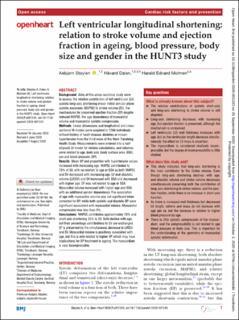| dc.contributor.author | Støylen, Asbjørn | |
| dc.contributor.author | Dalen, Håvard | |
| dc.contributor.author | Hansen, Harald Edvard Mølmen | |
| dc.date.accessioned | 2020-10-21T11:02:42Z | |
| dc.date.available | 2020-10-21T11:02:42Z | |
| dc.date.created | 2020-09-29T12:30:41Z | |
| dc.date.issued | 2020 | |
| dc.identifier.issn | 2053-3624 | |
| dc.identifier.uri | https://hdl.handle.net/11250/2684157 | |
| dc.description.abstract | Background: Aims of this cross-sectional study were to assess: the relative contribution of left ventricular (LV) systolic long-axis shortening (mean mitral annular plane systolic excursion, MAPSE) to stroke volume (SV), the mechanisms for preserved ejection fraction (EF) despite reduced MAPSE, the age dependency of myocardial volume and myocardial systolic compression. Methods: Linear dimensions and longitudinal and cross-sectional M-modes were acquired in 1266 individuals without history of heart disease, diabetes or known hypertension from the third wave of the Nord-Trøndelag Health Study. Measurements were entered into a half-ellipsoid LV model for volume calculations, and volumes were related to age, body size (body surface area, BSA), sex and blood pressure (BP). Results: Mean BP and proportion with hypertensive values increased with increasing age. MAPSE contributed to 75% of SV, with no relation to age or BSA as both MAPSE and SV decreased with increasing age. LV end-diastolic volume (LVEDV) and SV increased with BSA and decreased with higher age; EF was not related to age or BSA. Myocardial volume increased with higher age and BSA, with an additional gender dependency. The association of age with myocardial volume was not significant when corrected for BP, while both systolic and diastolic BP were significant associated with myocardial volume. Myocardial compression was less than 3%. Conclusions: MAPSE contributes approximately 75% and short axis shortening 25% to SV. Both decline with age, but their percentage contributions to SV are unchanged. EF is preserved by the simultaneous decrease in LVEDV and SV. Myocardial volume is positively associated with age, but this is only related to higher BP, which may have implications for BP treatment in ageing. The myocardium is near incompressible. | en_US |
| dc.language.iso | eng | en_US |
| dc.publisher | BMJ Publishing Group | en_US |
| dc.rights | Navngivelse-Ikkekommersiell 4.0 Internasjonal | * |
| dc.rights.uri | http://creativecommons.org/licenses/by-nc/4.0/deed.no | * |
| dc.title | Left ventricular longitudinal shortening: relation to stroke volume and ejection fraction in ageing, blood pressure, body size and gender in the HUNT3 study | en_US |
| dc.type | Peer reviewed | en_US |
| dc.type | Journal article | en_US |
| dc.description.version | publishedVersion | en_US |
| dc.source.volume | 7 | en_US |
| dc.source.journal | Open heart | en_US |
| dc.source.issue | 2 | en_US |
| dc.identifier.doi | 10.1136/openhrt-2020-001243 | |
| dc.identifier.cristin | 1834832 | |
| dc.description.localcode | © Author(s) (or their employer(s)) 2020. Re-use permitted under CC BY-NC. No commercial re-use. See rights and permissions. Published by BMJ. http://creativecommons.org/licenses/by-nc/4.0/This is an open access article distributed in accordance with the Creative Commons Attribution Non Commercial (CC BY-NC 4.0) license, which permits others to distribute, remix, adapt, build upon this work non-commercially, and license their derivative works on different terms, provided the original work is properly cited, appropriate credit is given, any changes made indicated, and the use is non-commercial. See: http://creativecommons.org/licenses/by-nc/4.0/. | en_US |
| cristin.ispublished | true | |
| cristin.fulltext | original | |
| cristin.qualitycode | 1 | |

